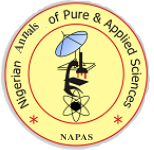Arrhenius-Type Relationship of Viscosity as a Function of Temperature for Mustard and Cotton Seed Oils
DOI:
Keywords:
Viscosity, Arrhenius Parameters, Model, Correlation, Statistics, Temperature, Vegetable oilAbstract
The knowledge and estimate of transport behaviours of fluids are very influential in heat and mass flow. In this study, an equation correlating the Arrhenius energy (Ea), the pre-exponential factor (A), the Arrhenius temperature (T) and the Arrhenius activation temperature (T*) is applied so as to buttress the depth of discussion. The results obtained from the viscosity experiments of Mustard and Cotton seed oils at different temperature ranges offers very good results statistically. The Activation energy Ea, Entropic (pre-exponential) factor A, Arrhenius temperature TA and the Arrhenius activation temperature for the mustard oil were observed to be 374.37381 J/mole, 12.39260595 cP, -17.89797783 oC, 45.051 oC respectively while Activation energy Ea, Entropic (pre-exponential) factor A, Arrhenius temperature TA and the Arrhenius activation temperature for the cotton seed oil are respectively 451.90611 J/mole, 8.210386507 cP, - 25.8292961 oC, 54.381 oC. The coefficients of regressions (R2) for the graph of the natural log of viscosity versus reciprocal of temperature (Figures 2 and 4) for the mustard oil and cotton seed oil are 0.9996 and 0.9996 respectively. Since the correlation coefficient is the measure of how well a collection of data points can be modeled by a line, we can hence conclude that the natural log of the viscosity of both seed oil samples versus the inverse of their respective temperatures have a very good fit.
Downloads
Published
How to Cite
Issue
Section
License
Copyright (c) 2020 E Ike

This work is licensed under a Creative Commons Attribution-ShareAlike 4.0 International License.



 Contact Us
Contact Us Editorial Team
Editorial Team Join As A Reviewer
Join As A Reviewer  Request For Print Copy
Request For Print Copy


 Cprint Publishers
Cprint Publishers